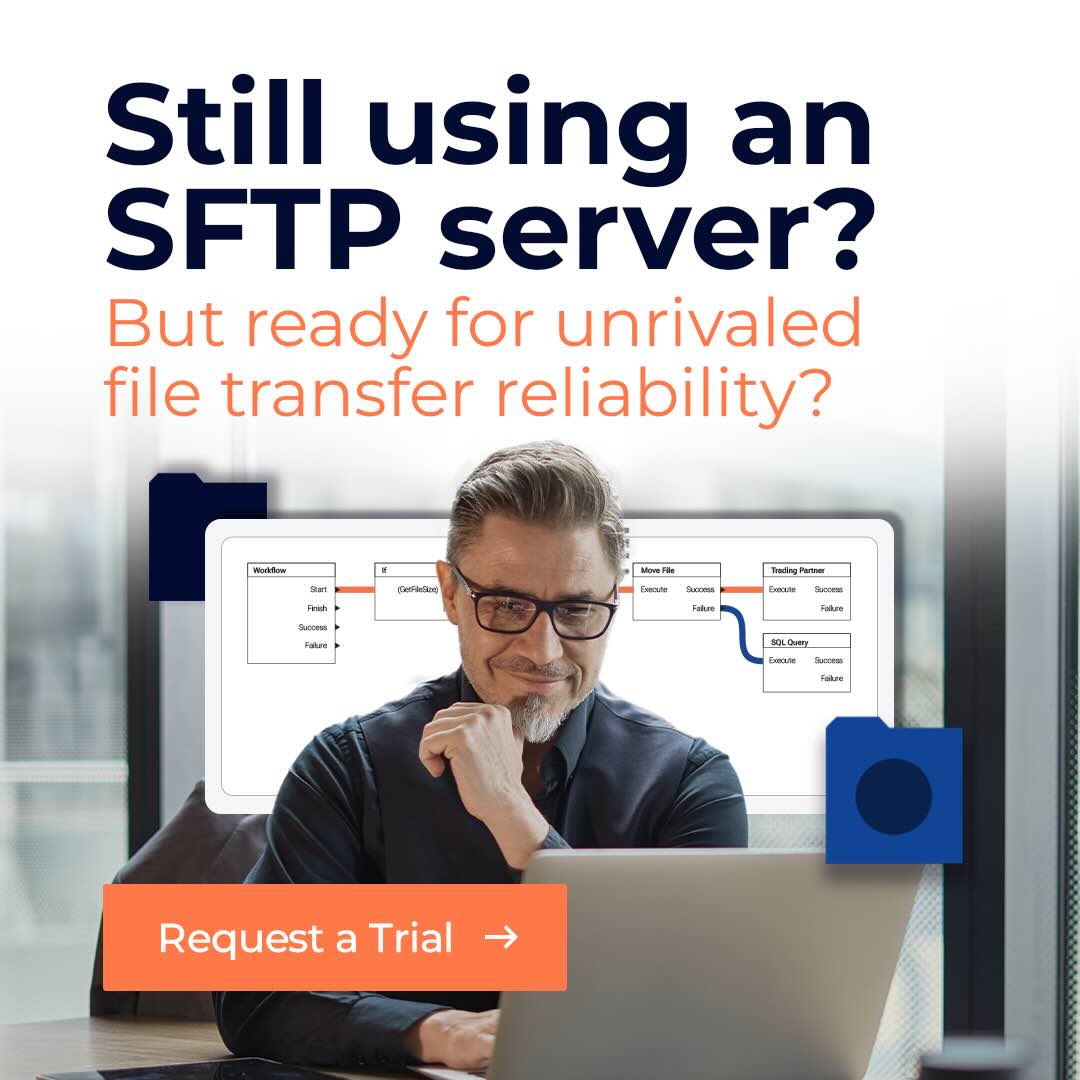What is dropdown#toggle” data-dropdown-placement-param=”top” data-term-id=”292784916″>Applicability Statement 2 is a dropdown#toggle” data-dropdown-placement-param=”top” data-term-id=”292784930″>data transfers. It’s based on the dropdown#toggle” data-dropdown-placement-param=”top” data-term-id=”292784907″>EDI).
The AS2-dropdown#toggle” data-dropdown-placement-param=”top” data-term-id=”292784907″>EDI is a way of exchanging standardized business documents. These documents contain business data structured in certain formats, such as XML, X12, or EDIFACT. By agreeing on a common standard when exchanging business documents, which are then known as dropdown#toggle” data-dropdown-menu-id-param=”menu_term_292784950″ data-dropdown-placement-param=”top” data-term-id=”292784950″> documents, dropdown#toggle” data-dropdown-placement-param=”top” data-term-id=”292784934″>interoperability.
In the past, two dropdown#toggle” data-dropdown-placement-param=”top” data-term-id=”292784950″>EDIdropdown#toggle” data-dropdown-placement-param=”top” data-term-id=”292784941″>VAN). Increased adoption of the Web and HTTP/S, however, paved the way for AS2. The dropdown#toggle” data-dropdown-placement-param=”top” data-term-id=”292784908″>trading partners to exchange dropdown#toggle” data-dropdown-menu-id-param=”menu_term_292784961″ data-dropdown-placement-param=”top” data-term-id=”292784961″> data directly, thereby eliminating the need for a dropdown#toggle” data-dropdown-placement-param=”top” data-term-id=”292784928″>AS2 protocol already comes with a robust selection of dropdown#toggle” data-dropdown-placement-param=”top” data-term-id=”292784907″>EDI dropdown#toggle” data-dropdown-placement-param=”top” data-term-id=”292784910″>authentication, data-in-transit encryption, data integrity checking, and non-repudiation. We’ll discussthese features in more detail later.
AS2 sample use cases
Order processing in the retail industry
AS2 is highly popular in the retail industry, where it is often used for various dropdown#toggle” data-dropdown-placement-param=”top” data-term-id=”292784961″>EDIdropdown#toggle” data-dropdown-placement-param=”top” data-term-id=”292784907″>EDI 837 files, which contain healthcare claims and billing payment information, to a healthcare payer.
[ Want to see how our AS2 solutions streamline data exchanges and enhance compliance. ]
What is dropdown#toggle” data-dropdown-placement-param=”top” data-term-id=”292784904″>SFTP stands for either dropdown#toggle” data-dropdown-placement-param=”top” data-term-id=”292784906″>File Transfer Protocol or dropdown#toggle” data-dropdown-placement-param=”top” data-term-id=”292784906″>File Transfer Protocol. It’s a secure, general-purpose dropdown#toggle” data-dropdown-placement-param=”top” data-term-id=”292784912″>SSH (dropdown#toggle” data-dropdown-placement-param=”top” data-term-id=”292784904″>SFTP is a subsystem in dropdown#toggle” data-dropdown-placement-param=”top” data-term-id=”292784905″>FTP
Although some people refer to dropdown#toggle” data-dropdown-placement-param=”top” data-term-id=”292784952″>Secure dropdown#toggle” data-dropdown-placement-param=”top” data-term-id=”292784904″>SFTP shouldn’t be confused with dropdown#toggle” data-dropdown-placement-param=”top” data-term-id=”292784905″>FTP or THE dropdown#toggle” data-dropdown-placement-param=”top” data-term-id=”292784905″>FTPS uses dropdown#toggle” data-dropdown-placement-param=”top” data-term-id=”292784938″>TLS for security, whereas dropdown#toggle” data-dropdown-placement-param=”top” data-term-id=”292784912″>SSH’s built-in security dropdown#toggle” data-dropdown-placement-param=”top” data-term-id=”292784904″>SFTP and dropdown#toggle” data-dropdown-placement-param=”top” data-term-id=”292784905″>FTP.
For a simplified discussion on the differences between dropdown#toggle” data-dropdown-placement-param=”top” data-term-id=”292784938″>TLS and dropdown#toggle” data-dropdown-placement-param=”top” data-term-id=”292784912″>SSH – A Not-So-Technical Comparison”.
Although dropdown#toggle” data-dropdown-placement-param=”top” data-term-id=”292784905″>FTP, it’s significantly more secure. dropdown#toggle” data-dropdown-placement-param=”top” data-term-id=”292784910″>authentication, and data integrity. dropdown#toggle” data-dropdown-placement-param=”top” data-term-id=”292784956″>security features, but plain dropdown#toggle” data-dropdown-placement-param=”top” data-term-id=”292784905″>FTP file transfers by running them through a virtual private network or dropdown#toggle” data-dropdown-placement-param=”top” data-term-id=”292784905″>FTP server, you’ll need to install, configure and deploy a dropdown#toggle” data-dropdown-placement-param=”top” data-term-id=”292784905″>FTP connections go through the dropdown#toggle” data-dropdown-placement-param=”top” data-term-id=”292784904″>SFTP, you only need to set up one solution for file transfers and for securing those transfers.
server-to-server file transfers, dropdown#toggle” data-dropdown-placement-param=”top” data-term-id=”292784942″>SFTPdropdown#toggle” data-dropdown-placement-param=”top” data-term-id=”292784943″>SFTPdropdown#toggle” data-dropdown-placement-param=”top” data-term-id=”292784947″>Supply chain server-to-server file transfers
server-to-server file transfers. Consider a dropdown#toggle” data-dropdown-placement-param=”top” data-term-id=”292784942″>SFTPdropdown#toggle” data-dropdown-placement-param=”top” data-term-id=”292784942″>SFTPdropdown#toggle” data-dropdown-placement-param=”top” data-term-id=”292784937″>AS2 vs. dropdown#toggle” data-dropdown-placement-param=”top” data-term-id=”292784904″>SFTP are both highly secure. However, their approach to specific dropdown#toggle” data-dropdown-placement-param=”top” data-term-id=”292784919″>functions differ. In this section, we’ll distinguish the approaches AS2 and SFTP take to implementmajor security dropdown#toggle” data-dropdown-placement-param=”top” data-term-id=”292784910″>authentication, encryption, data integrity, and dropdown#toggle” data-dropdown-placement-param=”top” data-term-id=”292784904″>SFTP dropdown#toggle” data-dropdown-placement-param=”top” data-term-id=”292784926″>firewall—yet another network security solution—we’ll also talk about firewall considerations.
dropdown#toggle” data-dropdown-placement-param=”top” data-term-id=”292784910″>authentication
While most file transfer solutions use usernames and passwords for dropdown#toggle” data-dropdown-placement-param=”top” data-term-id=”292784917″>digital certificate contains an AS2 dropdown#toggle” data-dropdown-placement-param=”top” data-term-id=”292784921″>public key. If two dropdown#toggle” data-dropdown-placement-param=”top” data-term-id=”292784917″>digital certificate (and its accompanying dropdown#toggle” data-dropdown-placement-param=”top” data-term-id=”292784908″>trading partner’s AS2 certificates for dropdown#toggle” data-dropdown-placement-param=”top” data-term-id=”292784918″>digital signature signed with its own dropdown#toggle” data-dropdown-placement-param=”top” data-term-id=”292784921″>public key. If both the dropdown#toggle” data-dropdown-placement-param=”top” data-term-id=”292784921″>public key match, the requesting party’s identity is considered authenticated.
Note that, while AS2 has built-in dropdown#toggle” data-dropdown-placement-param=”top” data-term-id=”292784910″>authentication, encryption and data integrity, you can also augment those features with those included in dropdown#toggle” data-dropdown-placement-param=”top” data-term-id=”292784938″>TLS. To do that, you must enable HTTPS on your AS2 solution.
dropdown#toggle” data-dropdown-placement-param=”top” data-term-id=”292784910″>authentication
Since dropdown#toggle” data-dropdown-placement-param=”top” data-term-id=”292784904″>SFTP deployments employ password-based dropdown#toggle” data-dropdown-placement-param=”top” data-term-id=”292784910″>authentication is sometimes augmented with dropdown#toggle” data-dropdown-placement-param=”top” data-term-id=”292784910″>authentication to achieve 2-factor dropdown#toggle” data-dropdown-placement-param=”top” data-term-id=”292784921″>public key dropdown#toggle” data-dropdown-placement-param=”top” data-term-id=”292784939″>SSHdropdown#toggle” data-dropdown-placement-param=”top” data-term-id=”292784910″>authentication, which also uses dropdown#toggle” data-dropdown-placement-param=”top” data-term-id=”292784921″>public key pairs, like certificate-based authentication, canbe used on its own, i.e., without being used in tandem with password automated dropdown#toggle” data-dropdown-placement-param=”top” data-term-id=”292784935″>algorithms, like dropdown#toggle” data-dropdown-placement-param=”top” data-term-id=”292784931″>decrypt and view your transmitted data.
AS2 encryption
AS2 provides data-in-motion encryption in two ways. The first is through its built-in AS2 encryption. The second is through HTTPS. So, if you use AS2’s built-in encryption, you can send your AS2 messages through unencrypted HTTP, and your messages will already be protected from man-in-the-middle attacks. However, for double protection, you can layer that built-in encryption with dropdown#toggle” data-dropdown-placement-param=”top” data-term-id=”292784938″>TLS encryption by sending your AS2 file transfers through HTTPS.
Both methods—built-in AS2 encryption and HTTPS-based encryption—use dropdown#toggle” data-dropdown-placement-param=”top” data-term-id=”292784933″>private key pairs.
dropdown#toggle” data-dropdown-placement-param=”top” data-term-id=”292784904″>SFTP derives its encryption capabilities from its underlying dropdown#toggle” data-dropdown-placement-param=”top” data-term-id=”292784904″>SFTP encryption uses public-dropdown#toggle” data-dropdown-placement-param=”top” data-term-id=”292784904″>SFTP encryption is that dropdown#toggle” data-dropdown-placement-param=”top” data-term-id=”292784904″>SFTP file transfer is always encrypted. In AS2, encryption is optional. You may or may not enable it when you configure AS2.
Data integrity
Upon receiving a file at the end of a file transfer, you might want to verify that it is intact and wasn’t tampered along the way. This can be achieved through data integrity checks.
AS2 data integrity
AS2 ensures data integrity by employing dropdown#toggle” data-dropdown-placement-param=”top” data-term-id=”292784935″>algorithms such as MD5, SHA-1, and SHA2. Before sending out an AS2 message, the sender runs the message through a dropdown#toggle” data-dropdown-placement-param=”top” data-term-id=”292784919″>function. It then sends the message together with the resulting dropdown#toggle” data-dropdown-placement-param=”top” data-term-id=”292784954″>hash, the recipient runs the same message through the same dropdown#toggle” data-dropdown-placement-param=”top” data-term-id=”292784935″>algorithm. If the resulting Understanding dropdown#toggle” data-dropdown-placement-param=”top” data-term-id=”292784904″>SFTP data integrity
Like AS2, dropdown#toggle” data-dropdown-placement-param=”top” data-term-id=”292784954″>hash dropdown#toggle” data-dropdown-placement-param=”top” data-term-id=”292784919″>functionality from the underlying dropdown#toggle” data-dropdown-placement-param=”top” data-term-id=”292784920″>Non-repudiation
Unlike dropdown#toggle” data-dropdown-placement-param=”top” data-term-id=”292784920″>non-repudiation is different from data integrity checking. While data integrity checks are beneficial to the recipient, dropdown#toggle” data-dropdown-placement-param=”top” data-term-id=”292784920″>non-repudiation through what’s known as dropdown#toggle” data-dropdown-placement-param=”top” data-term-id=”292784909″>MDN) receipts. It acts as an electronic receipt. If AS2 dropdown#toggle” data-dropdown-placement-param=”top” data-term-id=”292784908″>trading partners that are on the receiving end of an AS2 transmission automatically send back dropdown#toggle” data-dropdown-menu-id-param=”menu_term_292784960″ data-dropdown-placement-param=”top” data-term-id=”292784960″> receipts to the sending party. This will enable the sending party to confirm that the AS2 transfer went through without issues.
dropdown#toggle” data-dropdown-placement-param=”top” data-term-id=”292784926″>firewall is one of the most fundamental cybersecurity solutions. Every business will normally have a dropdown#toggle” data-dropdown-placement-param=”top” data-term-id=”292784926″>firewall. For this reason, it’s important to be familiar with the dropdown#toggle” data-dropdown-placement-param=”top” data-term-id=”292784906″>file transfer protocol. You need to know what ports to open to prevent dropdown#toggle” data-dropdown-placement-param=”top” data-term-id=”292784926″>firewall considerations
AS2 runs over HTTP or HTTPS. The standard ports for these protocols are port 80 and port 443, respectively. So you just need to open either one of those ports, depending on which underlying protocol you’re using for your AS2 connections. That shouldn’t be a problem since these port numbers need to be open for users to connect to websites. Most dropdown#toggle” data-dropdown-placement-param=”top” data-term-id=”292784904″>SFTP dropdown#toggle” data-dropdown-placement-param=”top” data-term-id=”292784904″>SFTP’s standard port number is 22. So if you’re using a standard port for your dropdown#toggle” data-dropdown-placement-param=”top” data-term-id=”292784926″>firewall.
When should you use AS2?
In many cases, your decision to use AS2 will not be a matter of choice but of necessity. Many large enterprises, such as Walmart, Unilever, and General Motors,either require or recommend the use of AS2. If you wish to transact with them, you’ll need to adopt AS2.
Some industries indirectly require AS2 as well. For instance, in the United States, organizations operating in the healthcare industry are mandated by law, through the Healthcare Insurance Portability and Accountability Act (dropdown#toggle” data-dropdown-placement-param=”top” data-term-id=”292784907″>EDI in healthcare information exchanges. Since AS2 is a natural fit for exchanging dropdown#toggle” data-dropdown-menu-id-param=”menu_term_292784961″ data-dropdown-placement-param=”top” data-term-id=”292784961″> data, it would be logical to use that dropdown#toggle” data-dropdown-placement-param=”top” data-term-id=”292784958″>Drummond Group certification means the product was rigorously tested and validated for reliability and dropdown#toggle” data-dropdown-placement-param=”top” data-term-id=”292784904″>SFTP?
Since dropdown#toggle” data-dropdown-placement-param=”top” data-term-id=”292784906″>file transfer protocol, you can use it for any other file transfer use case. You can use it to transfer large files, facilitate file sharing, send backups to a remote backup service, transfer files of any type, etc. You can even use it for dropdown#toggle” data-dropdown-placement-param=”top” data-term-id=”292784908″>trading partner supports.
Use dropdown#toggle” data-dropdown-placement-param=”top” data-term-id=”292784904″>SFTP
Some dropdown#toggle” data-dropdown-placement-param=”top” data-term-id=”292784906″>file transfer protocol for exchanging data. For example, some might prefer dropdown#toggle” data-dropdown-placement-param=”top” data-term-id=”292784904″>SFTP. Others may still want to exchange dropdown#toggle” data-dropdown-menu-id-param=”menu_term_292784950″ data-dropdown-placement-param=”top” data-term-id=”292784950″> documents using AS2 or OFTP.

In cases wherein you have to exchange data with multiple dropdown#toggle” data-dropdown-placement-param=”top” data-term-id=”292784922″>managed file transfer (dropdown#toggle” data-dropdown-placement-param=”top” data-term-id=”292784923″>MFT solution like JSCAPE JSCAPE MFTaaS will readily support AS2 and SFTP, along with other file transfer protocols such as FTP/S, HTTP/S, OFTP, etc. An MFT solution will enable you to easily meet any interoperability requirement.
See for yourself > Try JSCAPE.
That’s not the only reason to use an dropdown#toggle” data-dropdown-placement-param=”top” data-term-id=”292784923″>MFT solution like JSCAPE dropdown#toggle” data-dropdown-placement-param=”top” data-term-id=”292784956″>security features that augment the built-in security dropdown#toggle” data-dropdown-placement-param=”top” data-term-id=”292784915″>secure dropdown#toggle” data-dropdown-placement-param=”top” data-term-id=”292784904″>SFTP.
For instance, JSCAPE MFT Server also comes with strong authentication, data-at-rest encryption, data loss prevention (DLP), malware protection, high availability, and many more. A file transfer solution with extensive security capabilities will make it easier for you to meet stringent security policies and regulatory dropdown#toggle” data-dropdown-placement-param=”top” data-term-id=”292784923″>MFT solution like JSCAPE will always include automation and integration functionality. These capabilities will enable you to streamline business processes through automated workflows that transfer data in response to certain conditions in real-time.
Unlike in the SFTP sample use case above, automation isn’t implemented through scripts but rather through an easy-to-use graphical user interface.
If you’re curious about JSCAPE’s ability to improve your file transfer operations, simply request a risk-free trial here.





